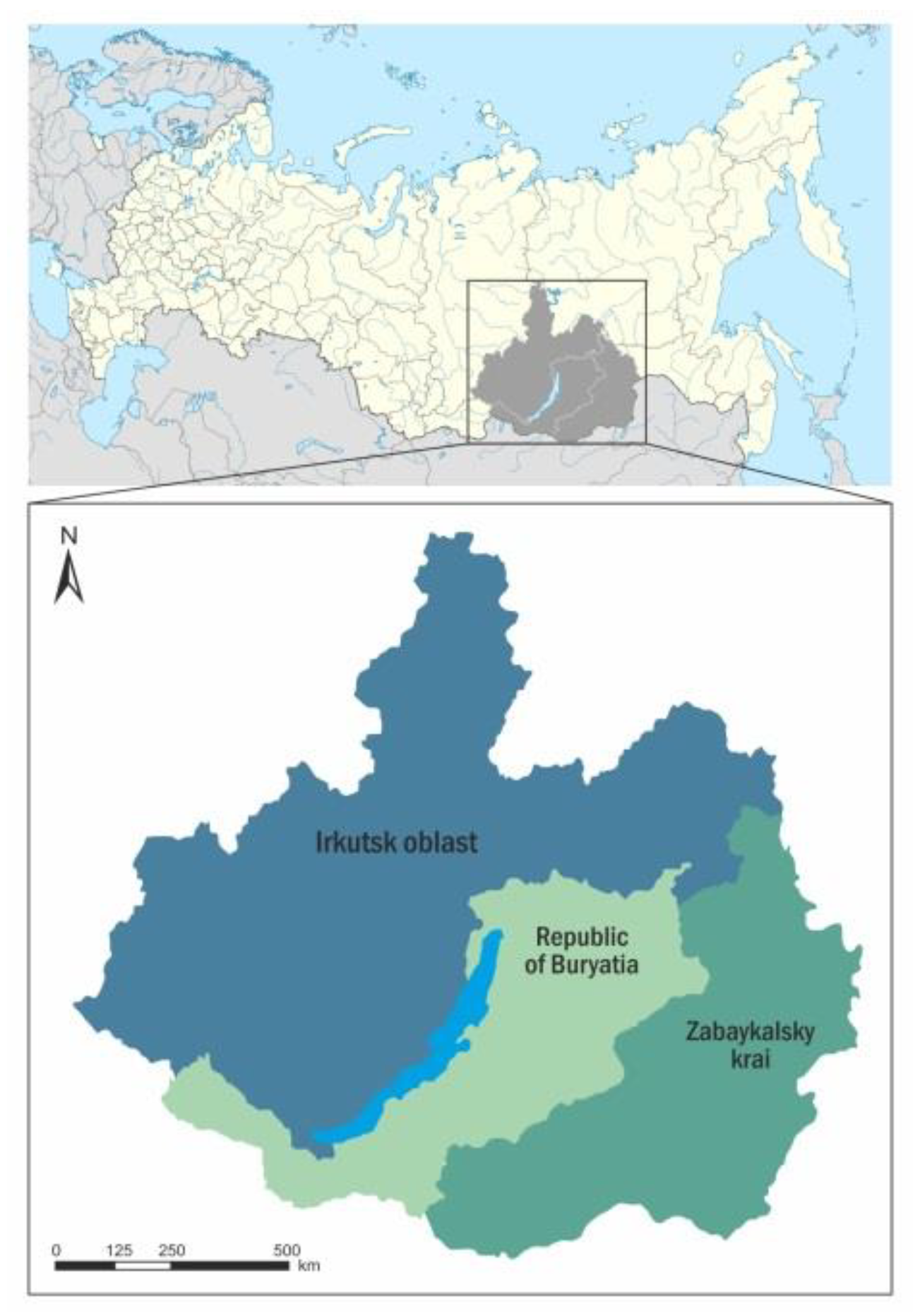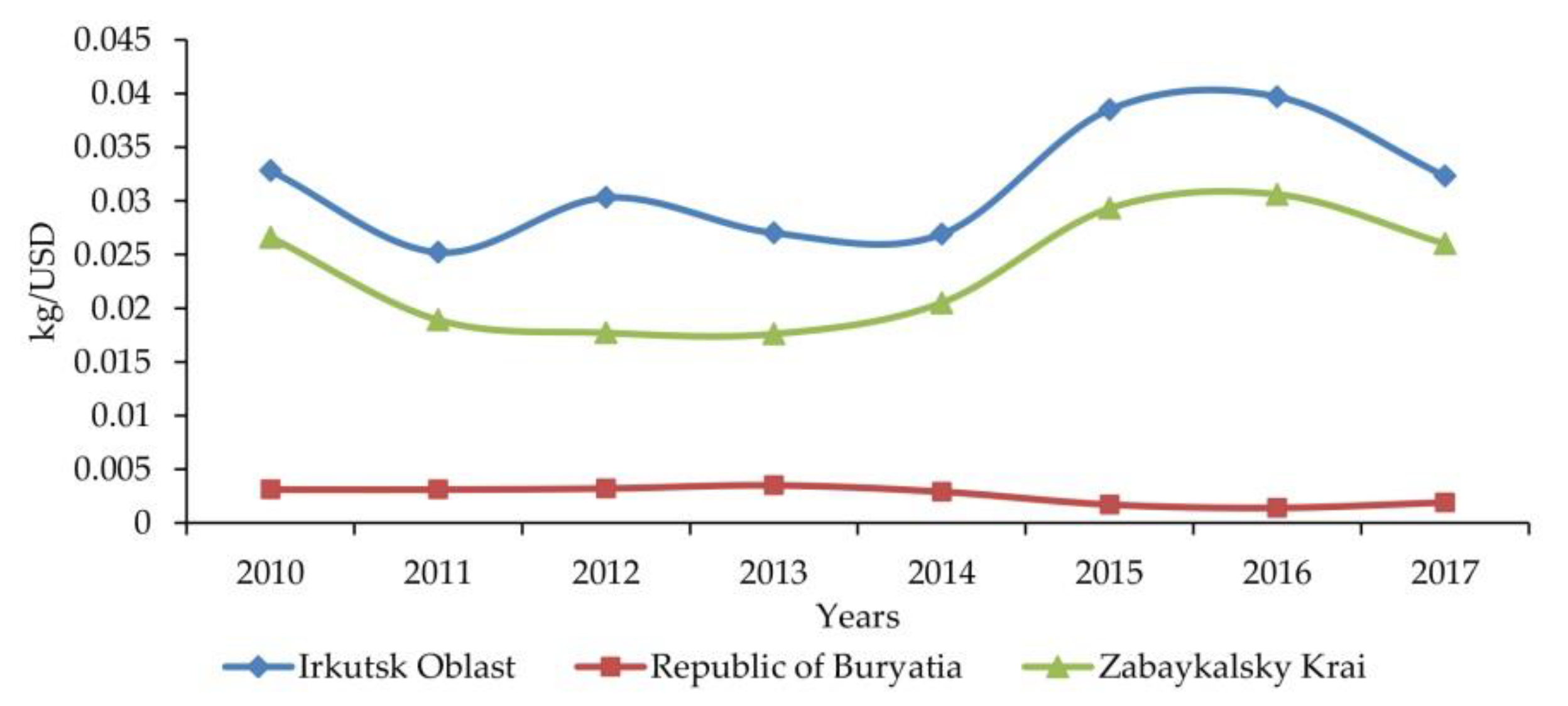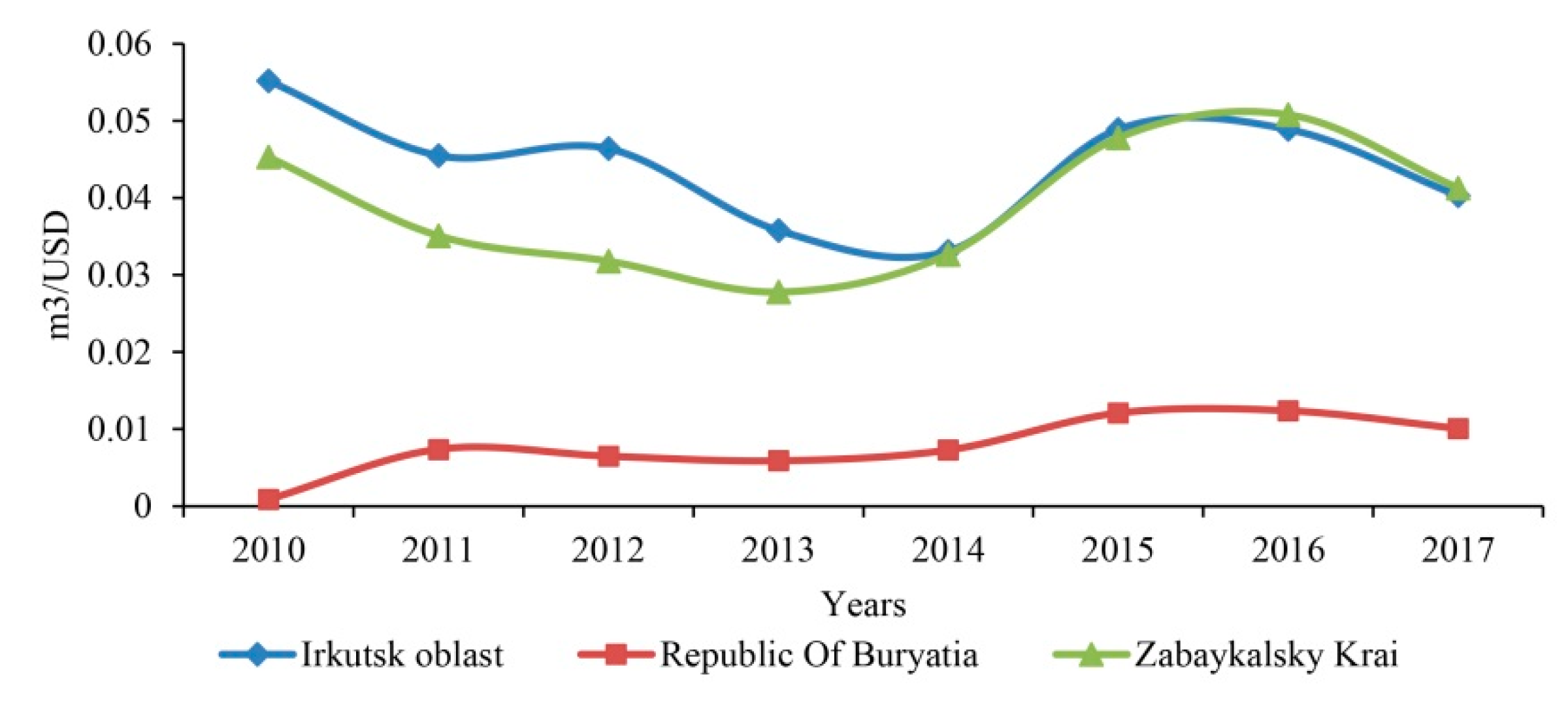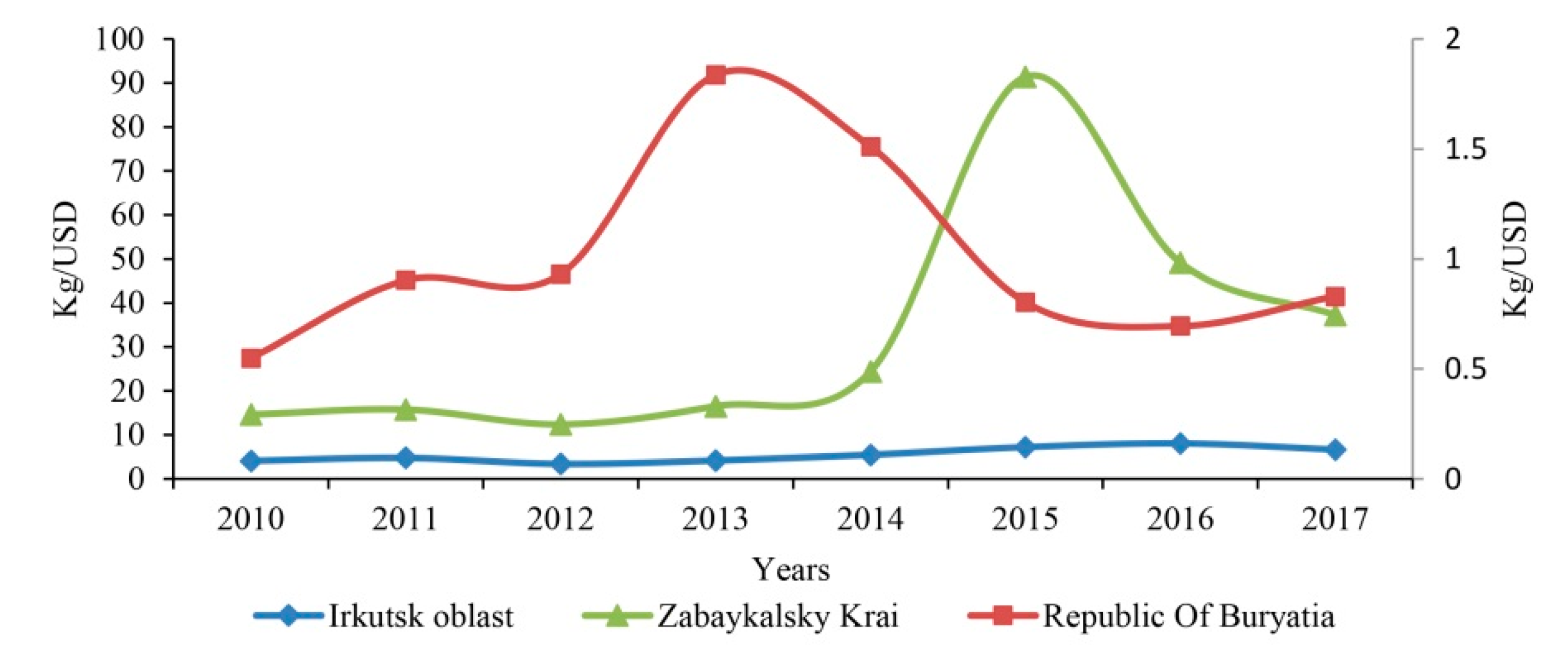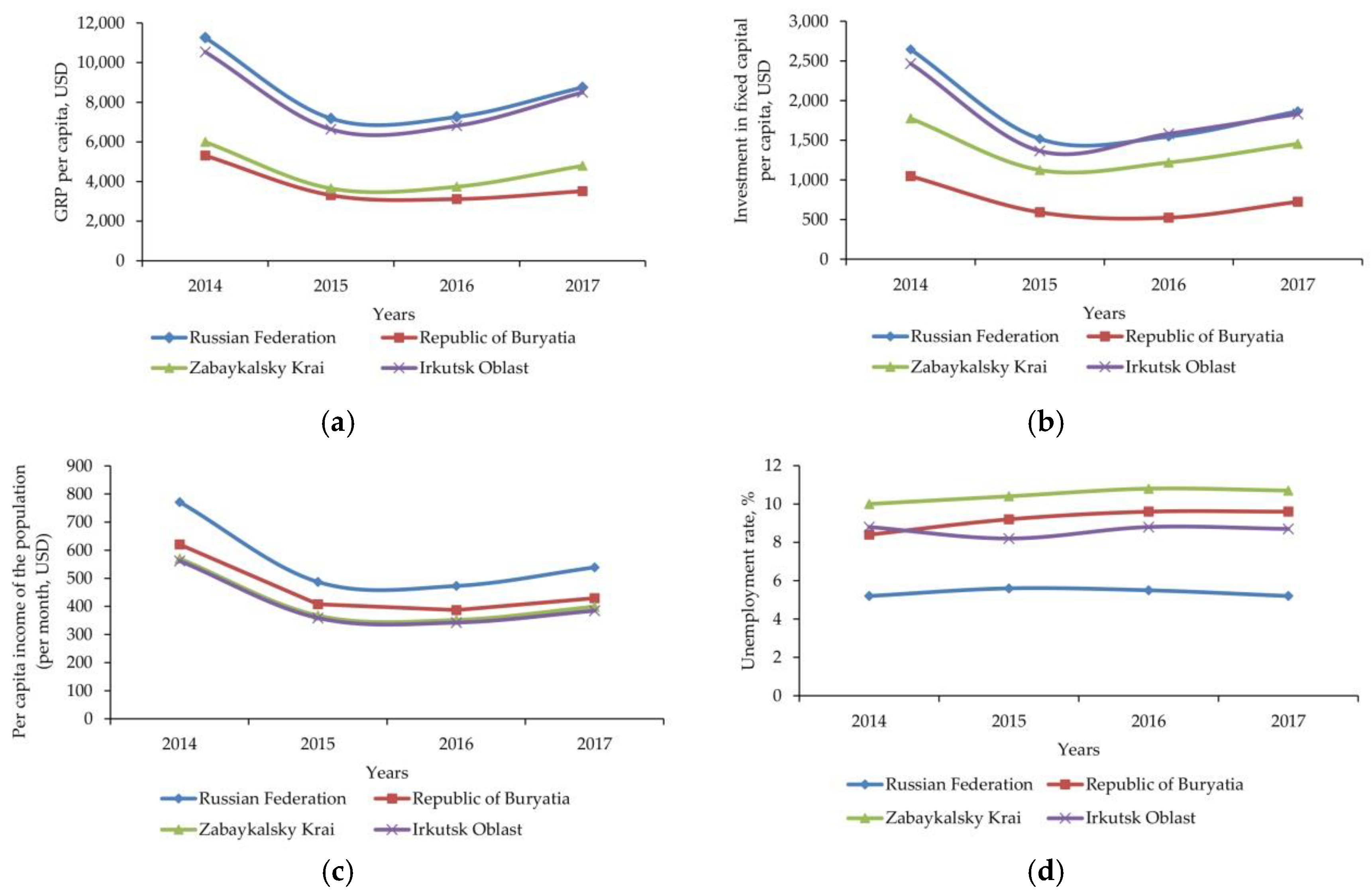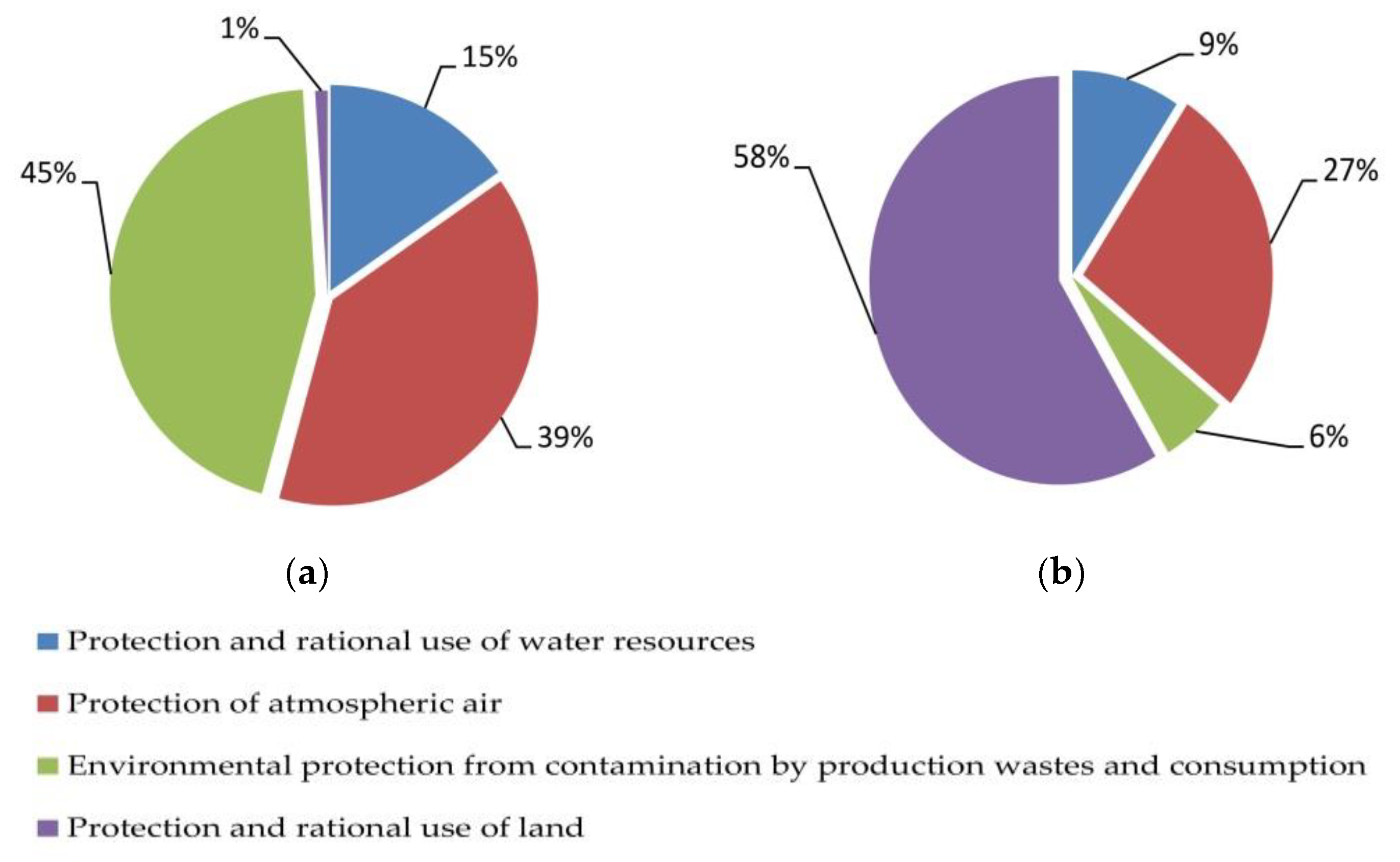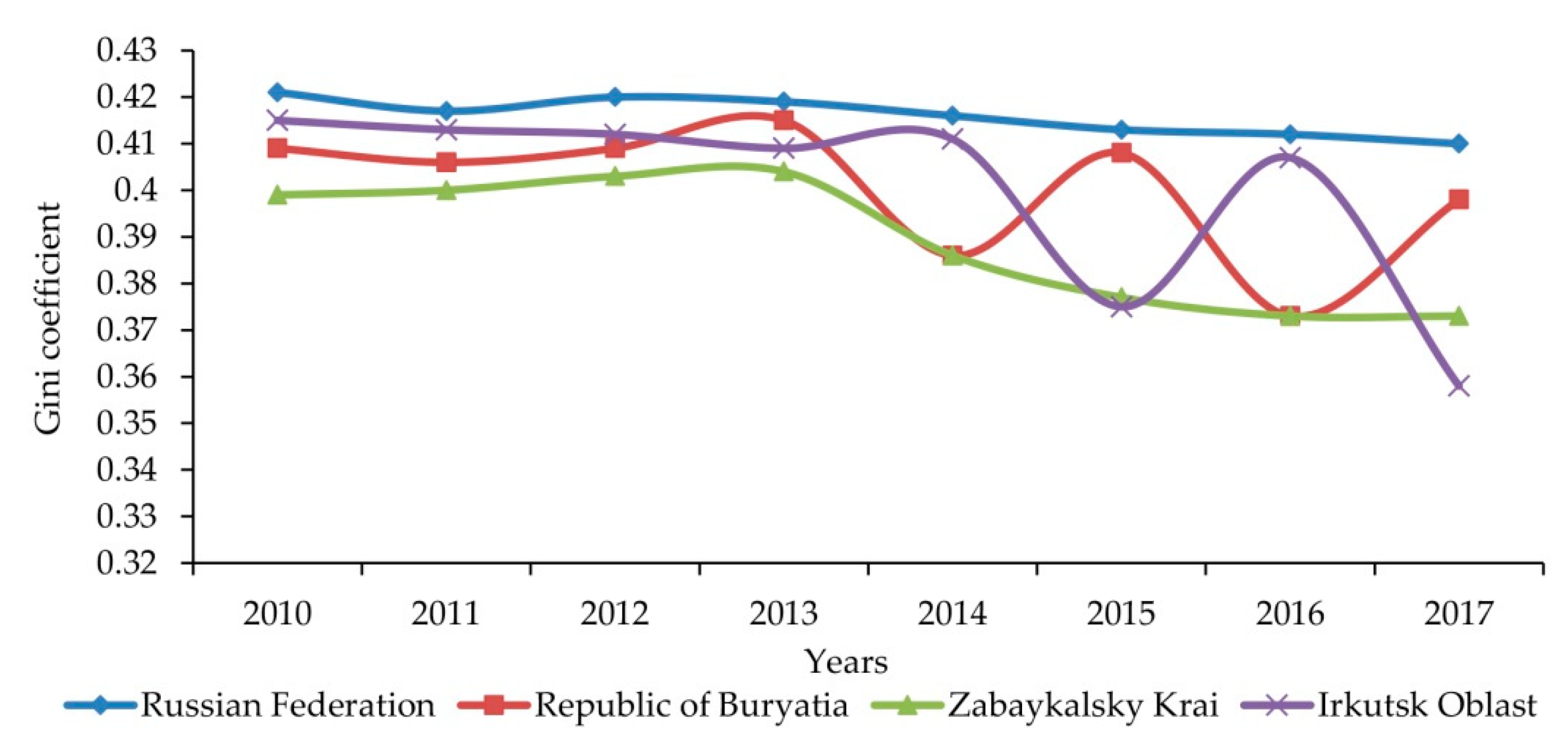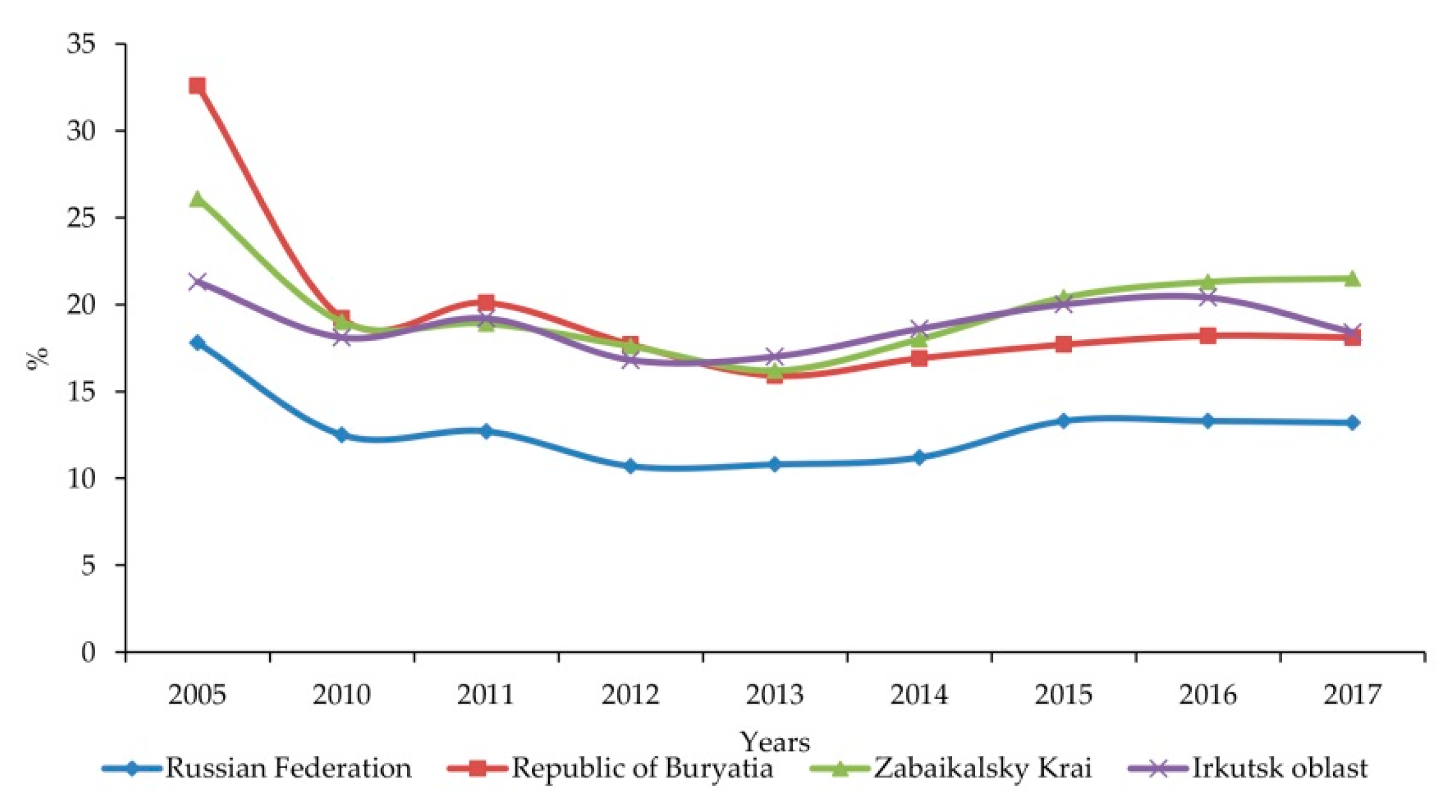1. Introduction
Since the end of the 20th century, humanity has been facing the problem of further development in the context of deteriorating ecological and socio-economic situations. The traditional path of economic development played a significant role in this. If this trend continues, it can lead to even more disastrous consequences with the destruction of ecosystems, extreme poverty, and the deterioration of people’s quality of life [
1].
Under these conditions, growing awareness of the global links between mounting environmental problems, socio-economic issues to do with poverty and inequality, and concerns about a healthy future for humanity have led to the concept of sustainable development. It strongly links environmental and socio-economic issues [
2].
The concept of sustainable development [
3], which presupposes independent development, combines the rational use of natural resources, the growth of economic and social indicators, and the preservation of favorable conditions for the life of the population. It has been given more recent urgency by four key international agreements, which were negotiated in parallel and all adopted in 2015: the Agenda 2030 for Sustainable Development, the Paris Agreement on Climate Change, Financing for Development, and African Union Agenda 2063. Each offers a vision for inclusive, sustainable, resilient, and low carbon development [
4]. Sustainable development is a basis of the green economy; a green economy contains all achievements of the concept of sustainable development—efforts to increase total human wellbeing, reduce social inequality, and lower the number and impact of environmental disasters [
5]. The overall goal of the green economy and sustainable development is to increase the level and quality of life of the population, with great attention paid to preserving and creating promising conditions for future generations.
During the late 1980s [
6], Pearce et al. framed the term “green economy”, relying on the idea of sustainable development and concerns about social issues, environmental problems, and economic development [
7]). A similar definition of “green economy”, which aims to bring together environmental conservation and alleviate poverty, was mainstreamed after the 2012 UN Conference on Sustainable Development in Rio de Janeiro (Rio+20) [
8], a focal point for the green economy internationally [
9]. This popular concept is perceived as a pathway to sustainability by international organizations such as the World Bank and the United Nations Environment Programme. The concept of a green economy is well-established in the political sphere, and it appears in many policy agendas of international institutions and, currently, more related to concepts linked to weak sustainability (i.e., energy efficiency or pollution control) [
10]. The concept envelops an umbrella perspective for a balanced social–environmental development with a global research area. In other words, the green economy is the most inclusive concept, including some ideas from both the circular economy and bio-economy [
11]. The UN reports and documents on sustainable development note that the basis for the transition to sustainable development is the formation of a green economy [
12]. The United Nations Environment Programme defines the green economy as one that “improves human well-being and social equity, while significantly reducing environmental risks and ecological scarcities” [
13]. In recent years, the green economy has emerged as one of several paradigms for fostering a growth path that integrates and reconciles economic, social, and environmental objectives [
14] We can see principles of the green economy were reflected in forward-looking documents and reports of UN conferences, supported by all countries. Here, we should highlight the priorities of the fight against climate change (2015) and the transition to sustainable development based on the formation of a green economy (2012) [
15]. In 2015, the UN developed and adopted the sustainable development agenda for the period until 2030, based on 17 sustainable development goals (SDGs) [
16]. It has its own indicators framework that measures progress towards achieving the SDGs [
17,
18] Adaptation of these documents will help develop long-term goals for the sustainable development of Russia [
19]. As it proposes solutions to produce more cleanly without generating waste or gas emissions, using materials and resources efficiently, and respecting nature, and eventually leads to higher sustainability [
20], it must not only be known but also applied [
21].
Currently in Russia, the following problems stand out on the path to the transition from a “brown” to a “green” economy [
22]: inefficient use of resources; the lack of an integrated waste management system; and territorial heterogeneity in economic development, in the standard of living, and the state of the environment. At the same time, in the Russian context, the process of regionalization is due to several objective factors, such as climatic, geographical, economic, ecological, and ethnic characteristics, as well as historically territorial and sectoral structures of the economy. These structures do not always correspond to the specialization and natural potential of the territories. Mainly these problems are concentrated in areas with unique ecosystems, which include the Baikal region. Therefore, this study resolved the issues related to conducting a comprehensive analysis and assessment of the ecological and socio-economic status of the territories to substantiate the strategic directions of the socio-economic development of the Baikal region, taking into account the environmental factor.
The scientific novelty and contribution of this study lie in the following aspects. Firstly, this is the first study that comprehensively examines the entire Baikal region from the green economy perspective, and this will allow local authorities to comprehensively understand the problems facing the region, formulate reasonable goals, and find ways to solve them based on its principles. Secondly, the results of the analysis and assessment of the ecological-socio-economic situation in the region can be used to predict the socio-economic development of the Baikal region, taking into account the impact of anthropogenic pollution on the environment, and make proactive management decisions to reduce pressures on the environment, also taking measures to improve the quality of life of the population of the region.
2. Materials and Methods
2.1. Study Area
The basin of Lake Baikal in its geographical and geopolitical position, natural resources, economic, ethnic, cultural, and personal potential, as well as directly thanks to Lake Baikal, is the central strategic region in eastern Russia and northern Mongolia (
Figure 1), the most important strong pillar of socio-economic development of the two countries. However, this development has its specifics since there is a special nature management regime in the Baikal Basin (federal law of Russian Federation May 1, 1999 N 94-FZ on “Protection of Lake Baikal”). The announcement of Lake Baikal and its environs as a World Heritage Site attracts the attention of the entire international community, underlining the role of great lakes both as a unique natural phenomenon and places for organizing recreation areas of global significance. It was promoted as a source of environmentally friendly land use and business in general. Since the reproduction and replenishment of this water occur throughout the basin of Lake Baikal, therefore, special attention is paid to nature conservation and there is a ban on many types of prey in order to avoid environmental changes.
The uniqueness of the Baikal region is determined by the wealth of natural resources, convenient border, and transit location [
23] in the center of the Asian part of Russia, as well as the ethnocultural characteristics of the peoples living in the territory where the center of Buddhism is located in Russia.
In this situation, on the one hand, there is an urgent need for the accelerated economic development of the Baikal region, on the other, there is the problem of preserving the purity of Lake Baikal.
In achieving sustainable development based on the principles of the green economy (development), efficient use, and reproduction of natural resources, environmental protection becomes the essential requirement for the development of any production. In the Baikal region, industrial production is a leading industry, and the main feature that determines promising future areas of development of production and economic activity of the territory is the presence of Lake Baikal.
Baikal natural territory within Russia covers three regions: the Republic of Buryatia (73%), Zabaykalsky Krai (21%), and Irkutsk Oblast (6%). In order to protect the unique ecological system of Lake Baikal, a special regime of economic and other activities were carried out by the principles of:
priority actions that do not violate the unique ecological system of Lake Baikal and its natural landscape protection zones;
taking into account the complexity of the impact of economic and other activities on the unique ecological system of Lake Baikal;
finding solutions of socio-economic tasks and tasks of protecting the unique ecological system of Lake Baikal on the principles of sustainable development; and
mandatory state environmental expertise.
Thus, the established special regime of economic and other activities imposes the most significant responsibility and burden for the purity of Lake Baikal on the Republic of Buryatia.
2.2. Statistical Methods
The method of constructing time series and the method of structural shifts allowed us to conduct a comparative analysis of indicators that characterize the environmental and socio-economic development of the Baikal region. For the example of the Republic of Buryatia, a comparative structural analysis of investments in fixed assets was conducted.
The study analyzed the eco-capacity by constructing a multiple regression equation.
To assess the factors affecting the eco-capacity of the discharge of polluted wastewater from the Republic of Buryatia, a model of the multiple regression equation was used, described by a function [
24]:
where
—regressand;
x—regressor;
f(x)—some function, according to it, the interaction of variables
Y and
x goes.
To build a multivariate relationship model, we used a linear multiple regression model:
To determine the factors that most influence the eco-capacity indicator, statistical analysis was performed using the software Statistica 8.0 on the example of the Republic of Buryatia. It allowed us to assess the current environmental situation and determine measures to reduce environmental pollution.
2.3. Environmental Pollution Assessment Indicators
The analysis of changes in the environmental sector of the Baikal region was carried out using the volume of air, water, and waste pollutants calculated per gross regional product (GRP) unit. The decrease in their values indicates positive trends that show the degree of technological shifts in the economy.
The next indicator that characterizes the environmental situation is the indicator of air and water pollution calculated per capita, thus determining the average environmental load per inhabitant for each territory that is part of the Baikal region. In Russian practice, such indicators are called “eco-capacity” [
25], which, to a certain extent, can characterize the current environmental situation in the region.
Eco-capacity of air pollution
is defined as the volume of atmospheric emissions per capita:
where
—number of people, unit;
—emissions of polluting substances in atmospheric air, kg.
Eco-capacity of water resources pollution
is defined as discharges of polluted sewage per capita:
where
—number of people, unit;
—discharges of polluted sewage, m
3.
The decrease in these indicators shows a positive trend, that is, the volume of pollution per inhabitant of the region decreases. Furthermore, the reverse dynamics show the intensity of the environmental situation.
2.4. Data
The information base of the study was constituted by regulatory acts of the Russian Federation, the Republic of Buryatia, statistical data of the Federal State Statistics Service [
26], and Rosstat territorial bodies for the Republic of Buryatia, Irkutsk Oblast, and Zabaykalsky Krai [
27,
28,
29] (
Table 1).
3. Results
By analysis and assessment of the current ecological and socio-economic situation of the Baikal region, the following results were obtained.
3.1. Current Ecological Situation in the Baikal Region
We analyzed indicators that characterize the environmental component of the development of the Baikal region, then analyzed the indicators of eco-capacity and built a multiple regression equation.
Consider the main indicators of environmental impact in the context of the subjects of the Russian Federation that are part of the Baikal region (
Figure 2,
Figure 3 and
Figure 4).
Analysis of statistical information for the period 2010–2017 showed that in the Baikal region, emissions of harmful substances increased by 61.6%, discharges of polluted wastewater decreased by 38%, and waste generation increased 2.3 times. In the structure of the federal subjects in the Baikal region in 2017, the leader in air pollution was the Irkutsk Oblast, which accounted for 82.7% of the total emissions.
The analysis of volumes of atmospheric emissions, wastewater, and wastes per GRP unit showed the following. The most significant decrease in the volume of atmospheric emissions per GRP unit in 2010–2017 occurred in the Republic of Buryatia and amounted to 38.7%, in Irkutsk Oblast—1.5%, and in Zabaykalsky Krai—2.3%. In recent years, the measures taken to reduce wastewater pollution in the Republic of Buryatia had the greatest positive impact on the indicator of the volume of wastewater per GRP unit; this indicator decreased by 11.2 times. In Irkutsk Oblast and Zabaykalsky Krai, there was a decrease of 27.0% and 8.8%, respectively. As noted above, an unfavorable situation was observed in the disposal of waste, which indicated an acute environmental situation associated with the formation, use, and disposal of production and consumption waste, for 2010–2017. In Irkutsk Oblast, the volume of wastes per GRP unit increased by 62.1%, in the Republic of Buryatia—51.2%, and in Zabaykalsky Krai—2.5 times. It occurred due to the intensive development of the extractive sector of the economy, especially in Zabaykalsky Krai.
Table 2 presents a comparison of the eco-capacity of emissions and discharges of pollutants in the Baikal region over the period 2010–2017.
For the period 2005–2017, eco-capacity of emissions of pollutants on average in the Baikal region increased in the Republic of Buryatia by 26.5%, in Zabaykalsky Krai by 2.1 times, and in Irkutsk Oblast—1.6 times. In terms of water resources in the Irkutsk Oblast, there was a significant decrease in eco-capacity; the reason was the closure of the Baikal pulp and paper mill, which previously worked directly on the shore of Lake Baikal.
In the Baikal region, the Republic of Buryatia is responsible for the cleanliness and quality of Lake Baikal since 73% of the lake basin is the territory of the republic.
Table 3 shows the contribution of the main sectors of the economy of the Republic of Buryatia to atmospheric air pollution in 2010–2016. Air pollution occurred as a result of the production activities of enterprises and vehicles. In 2017, the volume of emissions into the atmosphere on the territory of the republic amounted to 106.1 thousand tons, which was 19.6% more than in 2016 and 28.3% than in 2010. That is, in recent years, the total volume of air pollution tended to increase.
The structure of the contribution of the main sectors of the economy of Buryatia in 2016 shows growth in such sectors as agriculture (15%) and mining minerals (12.7%). Noticeable growth is noted in terms of production—42.1% was due to increased production capacity. As for the production of electricity, gas, and water increased, its share was reduced by 10.2%.
In this paper, we modeled the current economic situation, taking into account environmental parameters using the example of the Republic of Buryatia, which made it possible to identify the main factors that have the most significant impact on humans.
To assess the impact of the main factorial features on the indicator of eco-capacity of the discharge of polluted waste, we built a model of a multiple regression equation with a period of analysis of 2000–2017.
To build a model, the factorial features that include economic and environmental indicators were determined as exogenous variables using the expert method:
x1—production per capita, USD;
x2—share of investments in environmental protection, % to GRP;
x3—fixed assets per capita, USD
x4—unemployment rate, %
x5—per capita income of the population, per month, USD
After the pairwise comparison of the factorial features, we selected those factorial features that had a correlation coefficient value higher than 0.8.
The equation of multiple regression of eco-capacity on discharges of pollutants into water bodies is:
The model quality was checked by the F test. F value = 9539 and F critical value = 5.56. Since F value > F critical value, the regression equation, its parameters, and the indicator of the strength of relationship R are considered statistically significant.
As a result of eco-capacity indicator modeling estimated by discharges of polluted wastewater, the factors that had a positive impact include: production per capita (x1)—1587 USD, share of investments in environmental protection (x2)—3.571% of GRP, and fixed assets per capita (x3)—0.062 USD.
3.2. Current Economic Situation in the Baikal Region
The next stage in the study was an assessment of the Baikal region’s economic development level.
According to the ranking of regions of the Russian Federation for the quality of life in 2017, Buryatia ranked 76 out of 85, down one row in comparison with 2015 and 2016, Irkutsk Oblast—69 and Zabaykalsky Krai—81 [
30].
Figure 5 shows the analysis of the socio-economic development of the Baikal region.
As can be seen from
Figure 5, for the analyzed period in 2017 compared to 2016, growth in all indicators was observed in the region. The highest growth rates, exceeding the average Russian indicators of GRP per capita in Zabaykalsky Krai and Irkutsk Oblast, the Republic of Buryatia was the leader in investment per capita over the year. The unemployment rate in the region as a whole exceeded the average Russian level.
At the same time, it should be noted that the growth of the gross regional product itself is not evidence of a favorable economic situation in the regions. In current conditions, the success of the Russian economy directly depends on several market factors, including the increasing rate of extraction of natural raw materials and their subsequent sale on the world markets of mineral resources. This environmental problem is typical for the Siberian regions, where the extractive sector is one of the leading sectors in the economy.
In the Republic of Buryatia, there was a noticeable decline in industrial production, which was associated, among other things, with a decrease in gold production due to depletion of the mined deposits, so the high result of 2017 can be partly explained by the low base effect. However, gold production in the region increased over the period 2018–2019.
In the Baikal region, the economic situation is associated with the development and involvement of existing natural resources in economic turnover. As it is known, mining leads to waste. This environmental problem is characteristic. The extraction of solid minerals causes a violation of the existing hydrodynamic and geochemical conditions, due to the storage of rock masses, toxic chemical elements and compounds contained in them are released.
Investments are not only one of the most important factors influencing the development of the region’s economy as a whole, but also a factor having a key influence on the ecological situation. Investment supports achieving goals and solving problems on the path to greening and sustainable development of the region.
Table 4 presents data on the main indicators of investments in fixed assets aimed at environmental protection.
Related to the protection of the environment and the rational use of natural resources, gas–dust systems are being commissioned at the expense of the enterprises’ funds and also the repair of boiler equipment is being carried out. At mining enterprises, work continued on the reconstruction of enterprises and landfills for the disposal of toxic industrial waste.
Consider the structure of investments in fixed assets aimed at environmental protection in 2013 and 2017 (
Figure 6).
In
Figure 6, the structure of investments clearly shows how the proportions of the total volume of investments aimed at protecting the environment have changed. For example, despite the increase in the share of investments in air protection in the cost structure (9%), capital costs remained at about the same level. The same applied to the costs of protection and rational use of water, where the share of investments in 2017 decreased by 6%, but the capital costs remained almost the same.
3.3. Quality of Life
To assess the social component of the regional system, we used indicators that take into account the quality of life of the population.
Table 5 and
Figure 7 present the indicators of social development for 2010–2017 across Russia and the Baikal region.
The data for the period 2010–2017 show that in Buryatia, there was a tendency to decrease the ratio of average wages to their average size in Russia. As part of the state program of the Republic of Buryatia “Economic Development and Innovative Economy” for 2014–2024, approved by the Government of the Republic of Buryatia of 31.05.2013 No. 272, the subprogram “Employment Assistance” is being implemented and the whole complex of active employment policy measures are implemented in rural areas by the program “Promotion of Employment.” In 2013, the estimated proportion of rural residents receiving public employment services was about 50% (State program of the Republic of Buryatia “Economic Development and Innovative Economy” for 2014–2020, 31.05.2013 No. 272) [
31]. At the same time, the real effect of state actions did not have an impact.
Siberian regions are characterized by a high differentiation in the standard of living of the population. One of the main parameters characterizing the standard of living of the population is the amount of cash income.
During the analyzed period, in all subjects of the Russian Federation that are part of the Baikal region, there was a steady increase in income, but in 2014–2017 there was a decline in common with the all-Russia trend, but not as sharp as Irkutsk Oblast and Zabaykalsky Krai. In the structure of the money income of the population, wages were the primary source of income for the majority of the population of the Republic of Buryatia; for example, in 2017, its share was 33.7%. However, it was still lower compared to Zabaykalsky Krai, its share was 46.6%, and in Irkutsk Oblast, 56.6%. On average, in Russia, the share of wages in the structure of money income was 41.4%.
In the period from 2005 to 2017 in Russia as a whole, there was an increase in real money incomes of the population, and a turning point was the period 2014–2016 when there was a decrease in real incomes of the population in Russia. Thus, in Buryatia, each year the incomes were decreased by 1.6% from 2013 to 2014, 10.6% from 2014 to 2015 and 0.5% from 2015 to 2016 respectively. Similar dynamics can be traced in most regions of the Siberian Federal District, as well as the Far Eastern Federal District. In the period from 2005 to 2014, there was a rapid growth in income over expenditure, the difference between the amounts of income and expenses increased annually. At the same time, the place occupied by the republic in the ranking of subjects of Russian Federation on average per capita incomes as of 2017—46th, 2014—44th, and in 2012—55th. Among the eight federal districts of the Russian Federation, by this indicator, the Siberian federal district is the last—8th place.
From 2005 to 2013, there was a positive trend of poverty reduction in the population of the Republic (
Figure 8), but in 2014 there was an increase of 1.0% (16.9%), and in subsequent years this trend continued. In 2017, the population with income below the subsistence minimum in Buryatia was 18.1% of the total population of the region. It is also worth noting that the poverty level of the population of the Republic of Buryatia remained high compared to the average.
4. Discussion
According to the analysis, in order to increase the level and quality of life of the population of the Baikal region and the effectiveness of its economy, as well as achieve sustainable development based on the principles of the green economy and formation of a green economy development mode, the Baikal region should take the following steps.
(1) Attention should be paid to air pollution as a result of economic activity. As the analysis showed, among the subjects of the Baikal region, the leadership of the Irkutsk Oblast in the structure of emissions of pollutants is due to the placement on its territory of thermal power plants, chemical, petrochemical industry, and ferrous metallurgy.
Economic activity is usually accompanied by the burning of fossil fuels, while the corresponding amount of pollutants is emitted into the atmosphere. Therefore, special attention should be paid to the implementation of comprehensive action plans to reduce emissions of atmospheric pollutants in Irkutsk, Ulan-Ude, Gusinoozersk, and Selenginsk, taking into account the summary calculations of the negative environmental impacts permissible in these settlements. Investments play the primary role. In general, the picture of the dynamics of the volume of environmental investments for the period is somewhat controversial, for example, from 2012 to 2014 there is a general increase in investment, due to investments in the protection and rational use of land, and in 2010 they reach the maximum amount for the entire analyzed period. However, in 2015, we again see a decline; for 2017, the trend continued. All this testifies to sharp changes in growth and structural shifts in investments aimed at environmental goals.
Public administration in the field of air protection is based on the following principles:
priority of protection of life and health of present and future generations;
providing favorable environmental conditions for human life, work, and leisure; and
preventing the irreversible effects of air pollution on the environment (federal law of Russian Federation May 4, 1999 N 96-FZ on “Atmospheric Air Protection”)
The largest polluters of water bodies are enterprises engaged in the production and distribution of electricity, gas, and water. The formation of the maximum volume of wastes in the Republic of Buryatia is observed in the field of mining of ores and sands of precious metals, mining ores of rare metals, coal and lignite mining, and production of cement, lime, and gypsum. The main reason for the poor condition in the environmental protection sector for the extraction of mineral raw materials is that the funds allocated to the budget by enterprises themselves are not enough to overcome the negative trends in the subsoil use system, and especially when it comes to preserving the unique water body—Lake Baikal.
(2) In addition to protecting the environment, the main task is to reduce the number of poor people. The subsistence minimum established in the constituent entities of Russian Federation for the fourth quarter of 2017 averaged 9563 rubles per capita (164 USD) in the Republic of Buryatia. In the neighboring regions of Irkutsk Oblast and Zabaykalsky Krai, it amounted to 9825 rubles (168.5 USD) and 10,590 rubles (181.6 USD), respectively. The Republic of Buryatia occupies 41st place in the Russian Federation in terms of the subsistence minimum of the entire population, Irkutsk Oblast is 34th, and Zabaykalsky Krai is 21st. In particular, the high unemployment rate determines the number of problems: migration of qualified personnel to other regions of Russia and abroad; increase in the labor and social burden on the administrative centers Irkutsk, Ulan-Ude, and Chita due to residents arriving from rural municipalities; and insufficient compliance of the graduation structure of higher education organizations with the needs of the labor market—as in many other regions, the graduates are dominated by the fields of economics and management, and humanitarian sciences. Therefore, increasing the volume of production of goods and services in the Baikal region will give impetus to the creation of jobs with the potential to increase the number of arrivals and reduce the migration of qualified personnel. Furthermore, the development of transport infrastructure, in particular, an increase in the length of roads, will increase the volume of freight and passenger traffic.
(3) Baikal region is a bridge between Europe and Asia, which provides additional opportunities for the Republic of Buryatia as a border region. In these circumstances, it is possible to take advantage of the “one belt–one road” and “China–Mongolia–Russia economic corridor” initiatives to promote the green economic development of the region by attracting investment from neighboring countries, such as China and Mongolia. The republic has a high transit potential; it is close to the countries of the Asia-Pacific region and has a high environmental and natural resource potential. Nevertheless, to ensure the global competitiveness of investment and business conditions in the Baikal region, it is necessary to increase the attractiveness of the region for investors, including through the formation and popularization of the image of the macro-region in Russian and foreign mass media as a territory attractive for industrial investments.
It is proposed to establish special investment conditions for key sectors of the economy of the Baikal region in order to simplify the influx of investments in these sectors. For example, we recommend the extension of the existing mechanism for reducing electricity tariffs for industrial consumers to the average Russian level, the introduction of additional tax preferences, and the extension of the validity of work and business visas for foreigners participating in the implementation of investment projects in the Baikal region.
From 2008, China became the top trade partner for Russia, replacing Germany [
32]. In 2017, the Russia-China Investment Fund was established. Priorities for the fund are projects in the field of agriculture, energy, infrastructure, logistics, and new technologies, as well as projects within the framework of the conjugation of the Eurasian Economic Union and One Belt and One Road initiative, cooperation with the northeastern provinces of China and the regions of the Russian Far East. In turn, the Republic of Buryatia tops the rating of communication readiness of the regions of the Russian Federation to work with China. In the future, within the framework of the Russia-China Investment Fund, it will be possible to develop green investment projects for environmental facilities with environmentally friendly energy sources (natural gas, electricity, wood waste, and renewable energy sources).
(4) Thus, in order to achieve sustainable development and green economic development and overcome negative tendencies in the sectors of the national economy that harm the environment, as well as employment, living conditions, and reduction of the outflow of population from rural areas of the Republic of Buryatia, we recommend the following actions.
Measures for efficient and environmentally friendly development of heat and power supply of the central ecological zone of the Baikal natural territory based on the use of RES (renewable energy sources), small hydropower plants, and energy-saving technologies should be developed [
33]. As renewable energy is abundant, widely accessible, and progressively becoming cost-effective [
34], it could be used in the poorest communities to provide modern energy services [
35] and eventually lead to economic and environmental benefits [
36]. In the particular implementation of the transition to solar energy, there should be accelerated commissioning of solar panels and capacity building. For this, it is necessary to increase the efficiency of attracting investments from the state and private business in renewable energy. Buryatia is one of the favorable regions for this with a large number of sunny days a year. Although green energy facilities are being built or commissioned in the region, they are still not enough [
37]. The transition should be implemented as soon as possible; actions in the field of energy conservation will reduce environmental pollution. One option is to take advantage of the experience of China, where in 2017 alone investments in renewable energy amounted to 126.6 billion dollars, which is 23 billion more than all developed countries combined.
Projects to create green industries in the mining industry and the fuel and energy sector should be developed. Construction, modernization, and reconstruction of treatment facilities and wastewater disposal systems in the Baikal natural territory, increasing the length and the area of environmental engineering protection facilities and creation and modernization of basic transport and energy infrastructure should be initiated.
Preferential taxation for new green investment projects and the creation of special territories for socio-economic development with special conditions for the organization of green non-primary production-oriented to export should be implemented.
Monitoring compliance with applicable laws regarding environmental protection, as well as ensuring the environmental safety of the population and the preservation of natural systems are also important. Study of the negative impact of emissions and discharges of harmful (polluting) substances on the Baikal natural territory and development of scientifically based recommendations for their regulation and full coverage by the state environmental monitoring of the Baikal natural territory should be prioritized.
Accumulated damage to the environment in areas exposed to high and extremely high pollution and affecting Lake Baikal should be eliminated.
A mechanism for regulating the sustainable development of the Baikal region on the principles of the green economy and the inclusion of indicators of eco-capacity in the system of target indicators of state programs should be developed.
